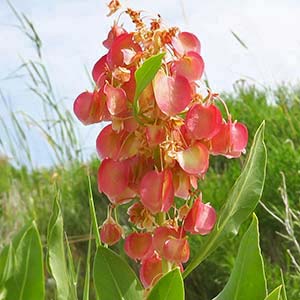Rumex venosus
Rumex cuneifolius
rumex veine, vein dock, veiny dock, wild-begonia, wing dock
Argentine dock, wedge-leaf dock
ascending or, rarely, erect, usually producing axillary shoots near base, (10–)15–30(–40) cm.
and axillary shoots ascending or erect, branching in distal 2/3, (5–)10–30(–40) cm.
blades ovate-elliptic, obovate-elliptic, or ovate-lanceolate, (2–)4–12(–15) × 1–5(–6) cm, subcoriaceous, base narrowly to broadly cuneate, margins entire, flat or slightly undulate, apex acute or acuminate.
blades distinctly obovate or obovate-elliptic, 5–8(–12) × (2–)3–5(–7) cm, widest in distal 1/2, rather fleshy, coriaceous, base cuneate, margins entire to obscurely repand, crisped or occasionally flat, apex obtuse, rounded.
terminal and axillary, usually occupying distal 2/3 of stem/shoot, usually dense, or interrupted in proximal part, broadly paniculate.
terminal and axillary, occupying distal 1/2–2/3 of shoots, usually dense at least in distal part, narrowly to broadly paniculate (but branches in most cases simple or nearly so).
articulated near middle, filiform or slightly thickened, (8–)10–16 mm, articulation distinct, slightly swollen.
articulated near middle or in proximal 1/3, thickened (especially distally), 3–5 mm, not more than 2–2.5 times as long as inner tepals, articulation distinct, swollen.
5–15 in whorls;
inner tepals distinctly double-reticulately veined, orbiculate or reniform-orbiculate, 13–18(–20) × (20–)23–30 mm, base deeply emarginate or cordate, margins entire, apex rounded, obtuse, rarely subacute, with short, broadly triangular tip;
tubercles absent, occasionally very small.
5–20 in whorls;
inner tepals ovate-deltoid or ovate-triangular, 4–5 × (2.5–)3–3.5 mm, base broadly cuneate or truncate, margins entire, apex obtuse or subacute;
tubercles 3, equal or unequal, finely punctate.
brown or dark brown, 5–7 × 4–6 mm.
glossy brown or dark reddish brown, 2.5–3 × 1.8–2.5 mm.
= 40.
= 40.
Rumex venosus
Rumex cuneifolius
Rumex venosus is a distinctive species rarely confused with any other members of the genus. However, I have seen herbarium specimens of it misidentified as R. hymenosepalus, and vice versa.
(Discussion copyrighted by Flora of North America; reprinted with permission.)
Rumex cuneifolius, a representative of the predominantly South American subsection Cuneifolii Rechinger f., is an uncommon alien known from a few localities in North America. It may have become naturalized in the southwestern part of the United States, especially in coastal regions. The species is known definitely from Portland, Oregon, and was reported as “apparently well established in s.c. Oregon” (C. L. Hitchcock et al. 1955–1969, vol. 2).
This species may have been reported from Provo, Utah, by Á. Löve (1986), as Rumex frutescens. However, it is not mentioned by S. L.Welsh et al. (1993).
The name Rumex frutescens Thouars has been misapplied to R. cuneifolius in both Europe and North America. According to K. H. Rechinger (1990), R. frutescens in the narrow sense is an endemic species of the remote South Atlantic islands Tristan de Cuhna and Gough; it differs from R. cuneifolius in having thinner rhizomes, shorter petioles and leaf blades, and smaller inner tepals. Rumex cuneifolius can hybridize with some other species (J. E. Lousley 1953).
(Discussion copyrighted by Flora of North America; reprinted with permission.)
- Local floras:
CA,
OR,
WA
- Local Web sites:
CalFlora,
CalPhotos,
Flora NW,
KS Wildflowers,
MN Wildflowers,
PNW Herbaria,
Turner Photog.
WildflowerSearch
iNaturalist (observations)
USDA Plants Database
- LBJ Wildflower Center
- SEINet
- Plants of the World Online
- Encyclopedia of Life
- Wikipedia
- Google Image Search


